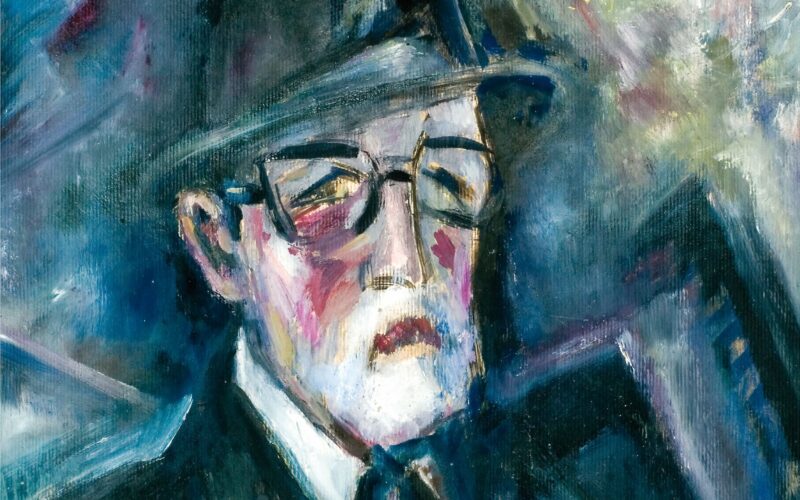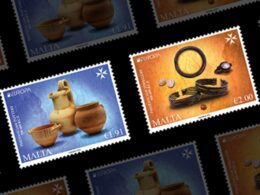A retrospective exhibition of paintings and etchings Carmelo Mangion: Mystery and Modernity by this pioneering Maltese artist is currently on show at Victoria’s Il-Ħaġar Museum. The works range from landscapes and religious works to still-lifes, portraits, and abstracted compositions.
The pivotal role played by Mangion (1905-1997) in the development of Modernism here in Malta, having been overlooked during much of his lifetime is now indisputable, and it is a pleasure to see, with this sizeable celebration, a long-overdue celebration of his place in Malta’s twentieth-century art history.
Mangion was slow to be recognised as a modern master because, as an introvert, he maintained a low profile throughout his life and was often thought to be a recluse. It is true that “he worked incessantly in his Sliema residence studio and retreated from social circles, only marginally participating in the artist collectives that were established locally from the mid-twentieth century,” says curator Nikki Petroni in the excellent book that accompanies the exhibition (Carmelo Mangion: Mystery and Modernity, il- Ħaġar Gem 34). However, she continues, “[this] judgement of Mangion as a recluse was, according to his daughter Adrienne Cassar, “an incorrect evaluation of her father.’” Instead, Cassar describes Mangion as a discerning man who loved companionship and conversation, but was very selective about the company that he kept.
A quiet non-conformist, and an innovator in his time, Mangion’s paintings are dramatic and dynamic with powerful colours and spontaneous brushstrokes full of vigour, zeal, and, possibly, angst, a style at odds with the social conservative on the islands as he “absorbed the movement of life, its excitements, anxieties and complexities.”

During the 1920s and 30s, whilst developing his artistic practice, Mangion spent time in Paris, Rome, New York and London, returning to Malta with a cosmopolitan outlook: it is perhaps unsurprising therefore that the colours and raw dynamic forms in this show are reminiscent of those of Paul Cézanne and Henri Matisse.
In il-Ħaġar, Mangion’s visionary works combine both the beauty and the industrial changes Mangion saw in the world around him, and in doing so he challenged both the accepted norms of Maltese art in the 1930s and 40s.
“The power station, for example, is not conveyed as a cold and distant steel monster but as a structure that affects the emotional and intellectual life of the modern world,” comments Petroni, arguing that the fundamental strength of Mangion’s art lay in his ability to intertwine the traditional with the radical and to re-present deeply embedded narratives and conventions. “Biblical and historical narratives were subverted and de-glorified as were their baroque aesthetics so pervasive in the religious visual culture of the Maltese islands,” she continues.

Visitors to the exhibition can clearly see this illustrated in Mangion’s ‘modern Gothic’ paintings of Floriana’s neo-gothic methodist Church. A clear rejection of the dramatic grandeur and elaborate ornamentation of the classical baroque tradition, Mangion presents this building as an unconventional slanting form in fiery blood orange. It’s an unsettling view that evokes an immediacy or even an urgency, and hints perhaps, at the mystery of life at this transitional time for mankind, at death, and what lies beyond.
This is seen again in Mangion’s paintings of St. John’s Co-Cathedral interiors which are set similarly off-kilter, his personal representation provoking questions rather than evoking a sense of magnificence.
Another stand-out painting in the show is that of Salome, the biblical seductress whose image has been reinterpreted countless times including by Caravaggio (this is not to be confused with seventeenth century Beheading of Saint John the Baptist which hangs in St John’s Co-cathedral in Valletta, but is stylistically similar). Look carefully and you’’ll see that the Mangion’s signature is even drawn with blood from the saint’s severed neck, a direct nod to Caravaggio whose own signature was also painted with John’s gushing blood.

In all other ways, Mangion’s representation of the scene however is strikingly different. He shows a seated Salome in a contemporaneous off-the-shoulder evening gown, slim and elegant in a high back gold-trimmed chair with a glass of red wine as she eyes the severed head of St John the Baptist which hovers before her, a slight smile playing on her reddened lips. It’s undoubtedly dramatic and yet feels cinematic rather than biblical, and the stark contrast in style between this work and classical representations speaks volumes of Mangion’s bold approach to art, of his pushback against tradition and his role in the development of modernism in Malta.
As Mangion’s luminous works received relatively little public exposure, his legacy to Maltese artists during the middle years of the twentieth century was primarily through his teaching activities. During his time in New York, he had absorbed a teaching philosophy that encouraged young artists – including William Apap, Anton Inglott and Emvin Cremona – to actively develop their own expressive and interpretative approaches. It is therefore largely through the work of those he taught here that his role in the development of the Modernist movement in Malta has been most evident.

Mangion also encouraged his students to experiment with new techniques of the Modern period, including linocuts, woodblock printing and collage, and etching, and a number of his own etchings are also on show.
Carmelo Mangion: Mystery and Modernity runs until at Victoria’s Il- Ħaġar Museum until September 8. Admission is free. For more information, visit www.heartofgozo.org.mt or follow Il-Ħaġar on social media.
The il- Ħaġar Gem Carmelo Mangion: Mystery and Modernity that accompanies the exhibition is available at the museum for €20.










